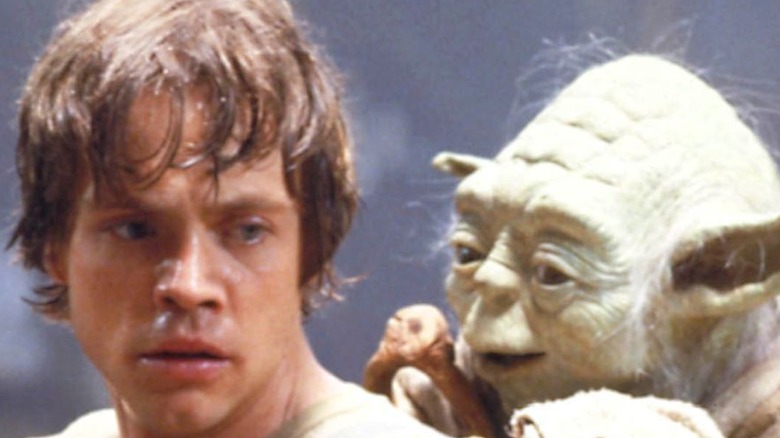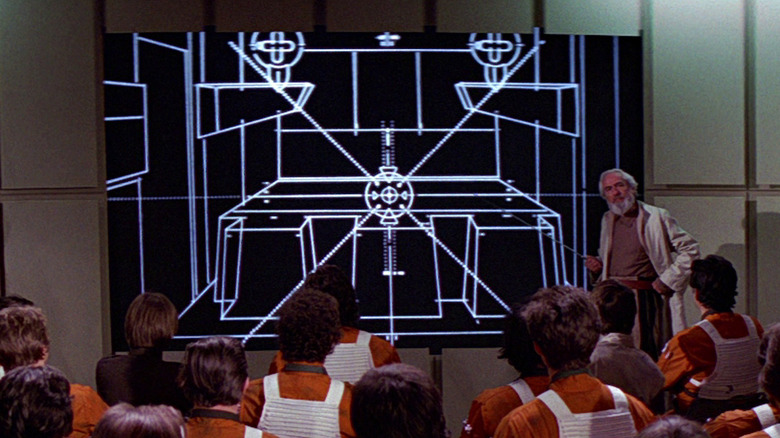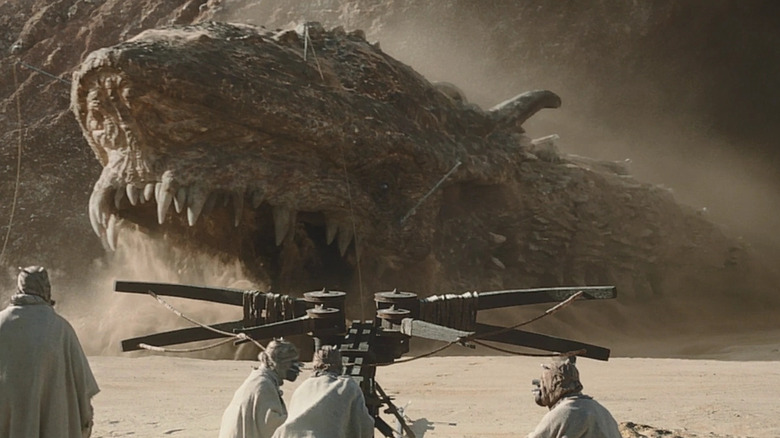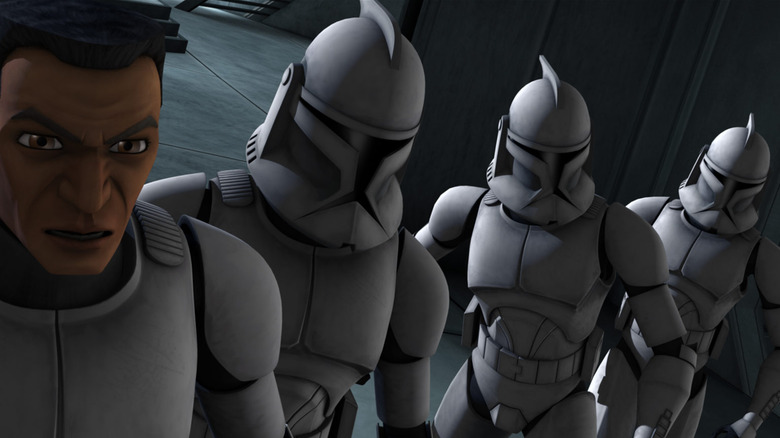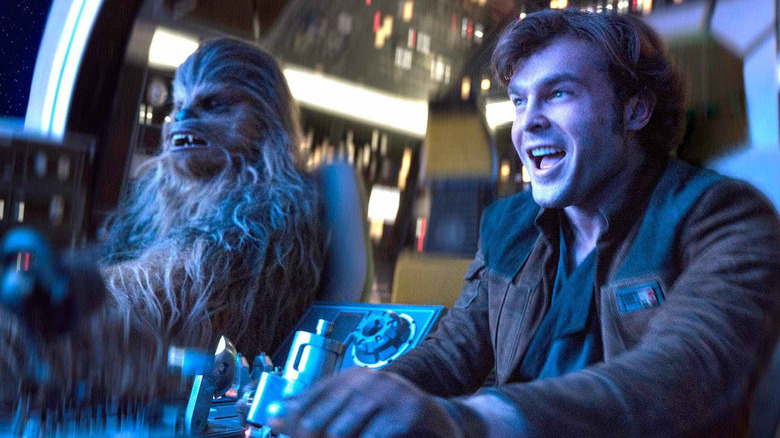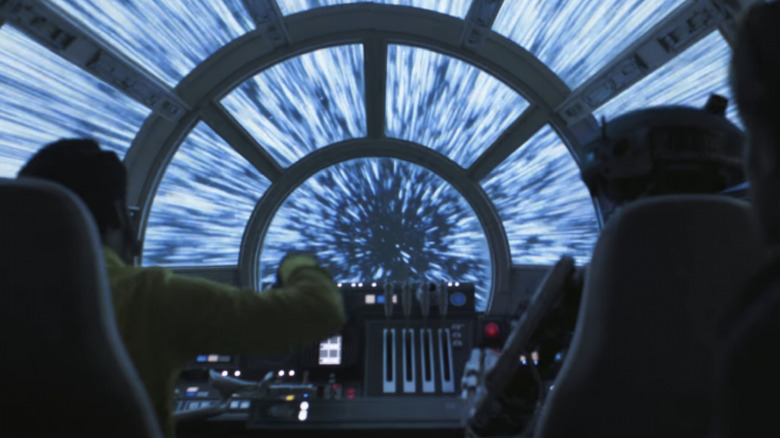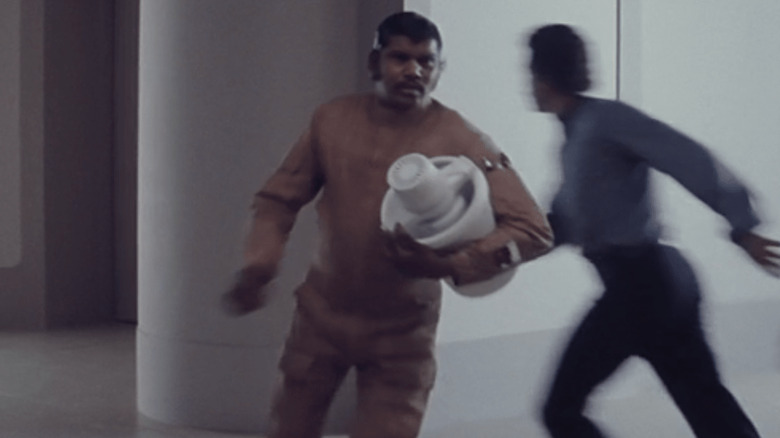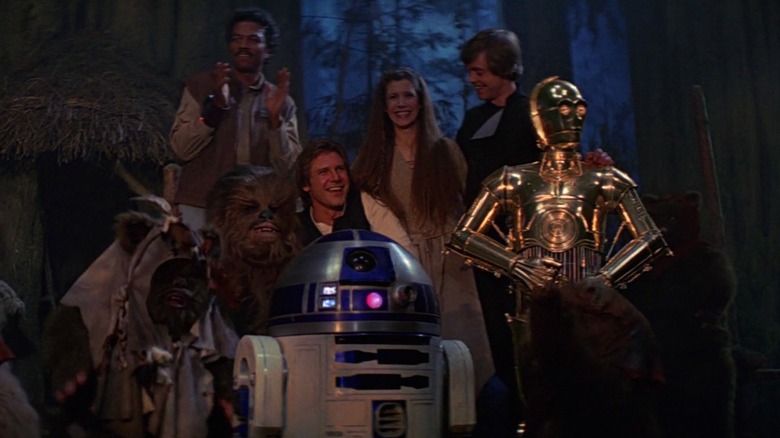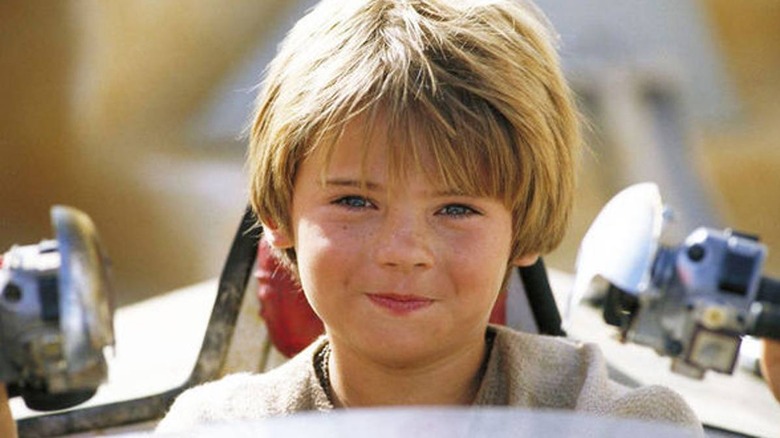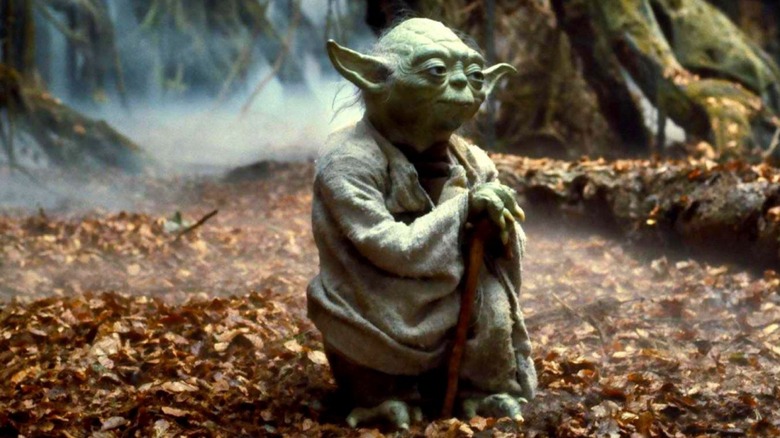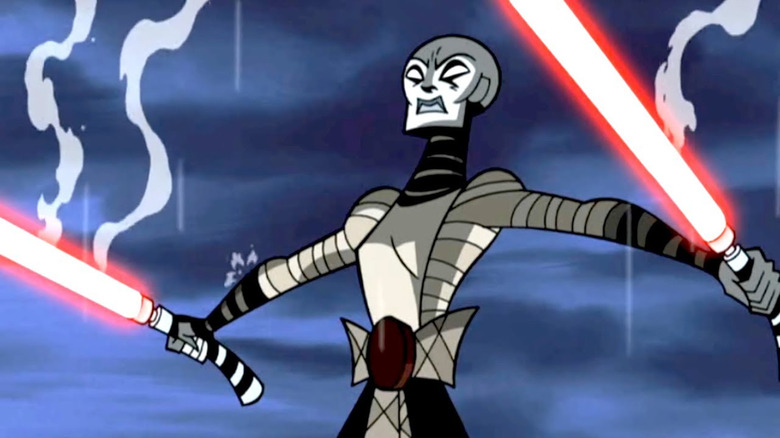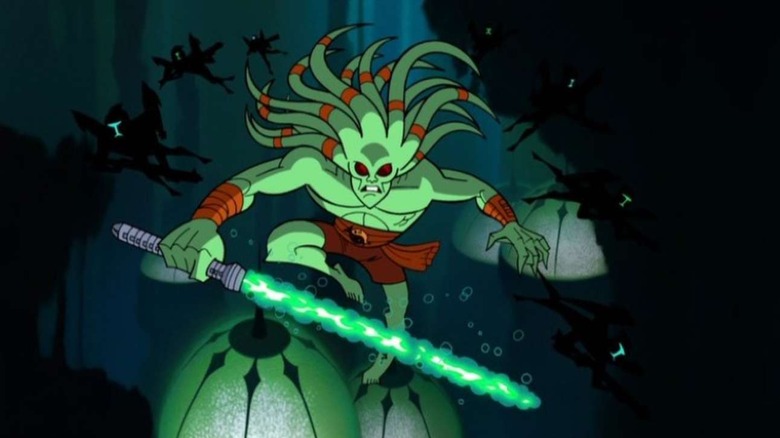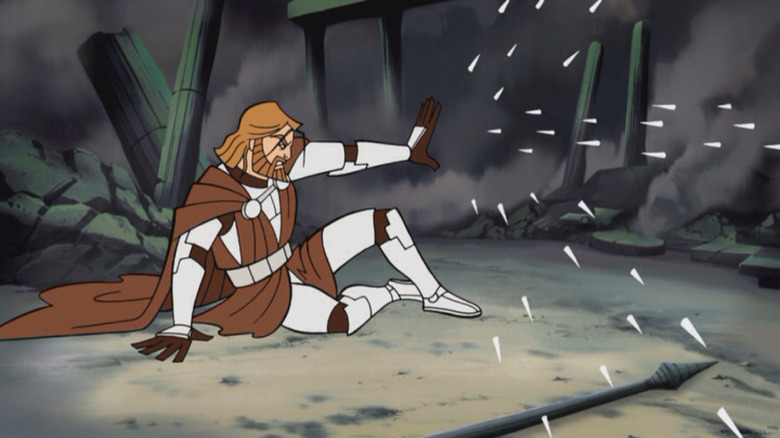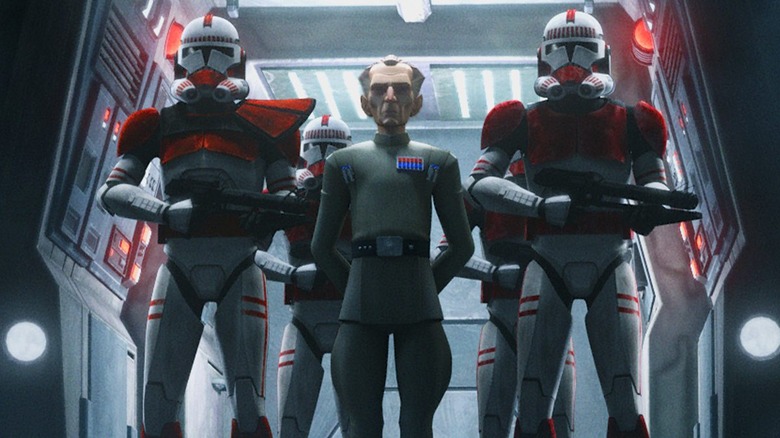Things We Learned About Star Wars Years Later
For nearly fifty years now, the "Star Wars" franchise has been releasing content — and though its pace isn't always quick, it has nevertheless managed to put out a dozen films, hundreds of television episodes across multiple series, thousands of books and comics — and one really terrible holiday special. If a Star Wars fan has a question, they can find the answer amongst Wookieepedia's 169,000+ encyclopedia entries, or rest assured that it will soon be answered in any one of a dozen Lucasfilm upcoming projects.
But this wasn't always the case. Children back in 1980 heard the shocking news that Darth Vader was Luke' father, then had to wait three years to find out if it was true. Fans of the original trilogy of films had to wait years before they could finally find out what happened after "Return of the Jedi," and decades before they could finally learn about the discussed-but-never-shown Clone Wars. Though fans can now enjoy the bliss of having more answers than questions, these were the questions that, for many, were the hardest to wait for more information on.
How did the Rebels get the Death Star plans?
Blaring trumpets roar and music swells as the first "Star Wars" opening text crawls across the screen in 1977: "Rebel spies managed to steal secret plans to the Empire's ultimate weapon, the DEATH STAR." As the movie ends and fans left theaters, it likely wasn't long before they began to wonder: "How did the rebels get those secret plans?"
Though "Star Wars" fans these days know the whole story, thanks to 2016's "Rogue One," this was actually the second time the question had been answered. In 1995, nearly twenty years after fans would have first wondered about the Rebels' grand heist, they finally received their answer in a video game titled "Star Wars: Dark Forces."
One of the first franchise video games ever, "Dark Forces" was a first-person shooter clone of the popular "Doom," one that featured a mercenary named Kyle Katarn who, in the game's first level, was hired by the Rebel Alliance to steal the Death Star plans. That was it. There was no grand heist or daring sacrifice. Just one guy who stormed an Imperial base by himself, taking off with the plans to the deadliest weapon in the universe.
What does a Krayt Dragon look like?
When C-3PO and R2-D2 first land on Tatooine, they wander through the dune sea, past what looks like an enormous set of dinosaur bones. These were identified as a "Krayt Dragon" for the first time in the "Star Wars" radio adaptation of the film from 1981. There, it's made clear that the sound Obi-Wan made to scare off the sand people that had attacked Luke was the roar of a Krayt Dragon. But one question remained: What did they look like when they were alive?
Though "The Marshal," the first episode of the second season of "The Mandalorian," may have given fans their first look at a Krayt Dragon in live action, they actually got their first look at one back in 2003 thanks to BioWare's hit role-playing video game, "Star Wars: Knights of the Old Republic." In it, the player has to locate an artifact that can only be found in a deep cave on Tatooine that just so happens to be the home of a monstrous Krayt Dragon. It was a difficult problem to solve, but it finally let Star Wars fans know what one looked like in the flesh.
What exactly were the Clone Wars?
In 1977, Obi-Wan gives Luke Skywalker the first grand revelation about his father: He wasn't a navigator for a spice freighter, but a Jedi who served in "The Clone Wars." This tantalizing name drop captivated Star Wars fans for decades. What were these clone wars, and who fought in them?
Though fans now have no less than two different animated television series, three theatrical films, and countless books, comics, and video games to help answer those questions, "Star Wars" fans of the 20th century had to wait until 1993, when the final novel of Timothy Zahn's "Thrawn Trilogy" was released.
In the novel, the Imperial Grand Admiral Thrawn was using clone technology from the mythic "Clone Wars" to grow himself a new army of stormtroopers in order to fight the New Republic. The heroes spend much of the plot trying to locate the hidden clone facilities, and, along the way, fans finally got their first descriptions of the Clone Wars.
Using vast facilities that could produce clones at insane speeds, the clone masters had used their artificial armies to assault the Republic and fight against the Jedi. It's quite different, but it's definitely fun to see what writers were imagining before fans finally got the answer in 2003's "Attack of the Clones."
How did the Millenium Falcon make the Kessel Run in 12 parsecs?
When bragging about his ship, the "Millennium Falcon," Han Solo quips that it made the Kessel Run in "12 parsecs." There's just one problem. "Parsec" isn't a made-up word; it's an actual unit of measurement for distance, not time, used in real-life astronomy. So, how did Han's ship make a trip shorter than would otherwise be possible?
Though many assumed for years that Han was simply doing a bad job of being a braggart, both Legends and Disney's new canon created an answer: The Maw. Basically, due to the complex nature of space travel, there is no direct route to Kessel because you have to fly around a black hole called "the Maw." In 2018's "Solo: A Star Wars Story," Han simply flies a more direct route by taking the "Millennium Falcon" closer to the black hole than usual, thus making the trip shorter. Who knew the answer could be so simple?
What happens when you hit something at light speed?
When Han, Luke, Ben, Chewie, and the droids make their escape from Tatooine in "A New Hope," Han educates Luke as to the finer dangers of hyperspace travel: basically, if they don't fully calculate their hyperspace jump, they will run into something and die. The basic image is pretty clear. Spaceship hits asteroid goes boom, but what would that look like?
Surprisingly, this was never really addressed or explored for forty years until "The Last Jedi" finally presented fans with "the Holdo Maneuver." Faced with a First Order fleet that can track them through hyperspace, what's left of the Resistance fleet is running out of fuel, out of time, and out of options.
In a last-ditch effort, Admiral Holdo launches all remaining Resistance forces towards their hidden base on the salt-planet Crait, while she turns their final capital ship around, aims it directly at the First Order fleet, and launches into hyperspace. The ship becomes a streak of light that slices through the fascist fleet like lightning — and the sequence is one of the most hauntingly beautiful sights to ever appear in a "Star Wars" film.
Why is that man on Bespin carrying an ice cream maker?
In the final part of "The Empire Strikes Back," Lando Calrissian tells the people of Cloud City that the Empire is taking control of the city, and that everyone should attempt to flee before more troops arrive. In the resulting scenes of chaos, a split-second shot specifically highlights a man carrying an ice cream maker as he flees the city. Later named "Willrow Hood," the man quickly became one of Star Wars' very first memes and was a favorite for cosplayers at conventions for decades.
But why on Bespin was he carrying an ice cream maker? The answer finally came after 39 years when "The Sin," the third episode of the first season of "The Mandalorian," identified Willrow's device as a type of Star Wars safe called a "camtono." It's a portable safe used to carry valuables, which is a far more sensible item to grab when fleeing from your home than an ice cream maker.
What happened after Episode VI?
It's 1983, and the Original Trilogy has concluded. The second Death Star is gone. Both the Emperor (well, for now) and Darth Vader are dead, and Luke Skywalker is officially a Jedi Knight. But what happens next? Fans would have to wait eight years for their first glimpse at an answer.
Though no longer canon after Disney's purchase of Lucasfilm and its subsequent release of the sequel trilogy, the original "sequel" to the franchise's first trio of films was a set of novels by Timothy Zahn known collectively as "The Thrawn Trilogy." The books were the first official novels that took place after the end of "Return of the Jedi," and showed fans how their heroes had faired in the interim.
Over the course of five years, Luke had become an even more powerful Jedi, but had not yet begun training students. Leia, on the other hand, was an important figure in the New Republic government, had married Han Solo, and was pregnant with their twins, Jaina and Jacen. Though the Empire was still not entirely destroyed, it was deeply fractured and its remnants were unorganized and on the run.
Then Grand Admiral Thrawn returned to unite the remnants, unleashing a new clone army against the fledgling New Republic. Though he was ultimately defeated, the character cemented his place as one of Star Wars' best villains and was ultimately reintroduced by Disney in "Star Wars: Rebels" and through his own series of novels.
How does Anakin not have a father?
In "The Phantom Menace," fans finally got to see what Anakin Skywalker looked like before he became the terrifying Darth Vader. Discovered by Jedi Master Qui-Gon Jinn on the planet Tatooine, the Jedi were shocked to learn that Anakin had no father but was instead the result of a Jesus Christ-esque "virgin birth."
Qui-Gon believed this meant that he was "the Chosen One," the mythic being of prophecy that was destined to destroy the Sith and bring balance to the Force. Many fans were bothered by this for a number of reasons, but one of the most persistent questions was, "How does Anakin not have a father?"
This question would be left as unexplored as midi-chlorians for nearly thirteen years, until Star Wars published the novel "Darth Plagueis" by James Luceno. The novel tells the story of the Sith Lord that trained Emperor Palpatine, detailing their efforts to explore the Force power that allows a person to literally use the Force to create life. During their experiments, they accidentally and unknowingly created Anakin Skywalker — the very person that would, eventually, destroy the Sith.
Can Yoda fight?
When audiences first met Yoda in "The Empire Strikes Back," the wizened Jedi Grand Master was near the end of his very long life, and whether it was because of his age or that he was a literal puppet being played by Frank Oz, Yoda didn't perform too many physical feats. After watching the flips, kicks, and fights of Luke Skywalker, many fans began to wonder just what Yoda fighting would even look like.
Twenty long years after his death in "Return of the Jedi," moviegoers finally got to see Yoda a little closer to his prime in "Attack of the Clones" when the Jedi Master confronts his fallen apprentice, Count Dooku. After defeating Anakin and Obi-Wan at once, Dooku turns to see his old master hobble into the room with his cane, and after measuring each other up, fans finally saw the moment they had all been waiting for as Yoda threw down his cane, drew his lightsaber, and ignited it.
He then proceeded to somersault throughout the room wildly as he attempted to defeat Count Dooku in a pitched duel, and fans finally understood how a being so small might possibly fight with a lightsaber. Whether or not the scene is impressive or ridiculous varies from person to person, but at the time, audiences in the theaters gave it the biggest cheer of any scene.
How do lightsabers react to rain?
Throughout the first five Star Wars films, fans watched as lightsabers cut through robes, limbs, metal railings, blast doors, waistbands, necks, and limbs again — but for all fans had seen of these civilized weapons, there were still many practical considerations that they didn't know. For example, how do lightsabers react to the rain?
Soon, came famed animator Genndy Tartakovsky to the rescue. In 2003, after the release of "Attack of the Clones" but before the release of "Revenge of the Sith," Hasbro and Lucasfilm collaborated with the creator of "Samurai Jack" to produce a series of animated cartoon shorts that would simultaneously promote both films and all of their related toys.
The series of shorts, streamed on Disney+ now as "Star Wars Vintage: Clone Wars 2D Micro-Series," was collected into two volumes. "Volume 1" features both the first appearance of Asajj Ventress and her first duel with Anakin Skywalker — during which, the two combatants pause for a moment as the weather changes and it slowly begins to rain.
As the raindrops fall, a few start to hit the blades of their lightsabers, and they just ... turn to steam. It's hard to know what fans were expecting, but there must have been at least one child sitting on his living room floor that was simultaneously amazed and bemused that he hadn't thought of that himself.
Can lightsabers be used underwater?
Alright, rain makes sense. There clearly isn't enough water at once to even come close to "putting out" the lightsaber — but what if the lightsaber was completely submerged? Well, fans got their first idea of how this might work in the novel "Young Jedi Knights: Crisis at Crystal Reef" and the guidebook "Jedi vs. Sith: The Essential Guide to the Force." From those books, fans learned about a "bifurcating cyclical-ignition pulse" that simultaneously make a lightsaber hilt waterproof and allow a lightsaber to be ignited underwater.
Basically, it works like this. In order to function, lightsabers require a focusing crystal; running power through the crystal is what creates the actual blade, but when completely submerged in water, that power can short out and disable the lightsaber. By splitting that power between two crystals and "bifurcating" the power flow, the hilts can make the energy cycle between the two crystals, presumably creating some sort of energy seal around the crystals and boosting the blade's power enough to withstand water.
Fans finally got to see that theory in action during the first volume of Genndy Tartakovsky's "Star Wars Vintage: Clone Wars 2D Micro-Series," when Jedi Master Kit Fisto led his clone troopers against a droid army on the water planet Mon Calamari. As the battle begins, he activates his lightsaber, which has a unique shimmer to it — then dives into the ocean and starts swinging away.
Can Jedi stop bullets?
One of the most common questions that new Star Wars fans ask is, "Can a Jedi stop a bullet?" Referred to as "slug-throwers," projectile weapons do exist in the Star Wars universe, and they are occasionally used against Jedi in the hope that they won't be able to just deflect them like blaster bolts. Unlike blaster bolts, this theory goes, lightsabers would simply melt bullets but not disintegrate them, thus forcing any Jedi who tried to block a bullet with their saber to shower themselves in molten metal — which would hurt.
Fans needn't worry, as demonstrated by Jedi General Obi-Wan Kenobi in the first volume of Genndy Tartakovsky's "Star Wars Vintage: Clone Wars 2D Micro-Series." While facing off against a bounty hunter named "Durge," Obi-Wan impales the man with his lightsaber, but the strange alien simply laughs and knocks Obi-Wan away, depriving him of his weapon.
Durge assumes that Obi-Wan is defenseless and moves to simply shoot the Jedi with his fully-automatic wrist-fired gun, but when the thousands of projectiles go screaming through the air at Kenobi, the Jedi Master simply raises his hands, and redirects their path with the force so they go around and away from him. Not a single one hits him, and this just might answer why nobody ever tries to kill a Jedi with a bullet.
What did the Empire do with all of the Clones?
When "Attack of the Clones" finally revealed the nature of the Clone Wars, it was pretty clear these clones were the precursors to the Empire's Stormtroopers. It was just as clear, however, that these clones were no longer around during the original trilogy, but then "Revenge of the Sith" ended in 2005 with the clones still filling that role. So what happened to them?
Set immediately after the rise of the Empire, "Star Wars: The Bad Batch" spends a decent amount of time exploring what happens to the clones under the Empire, but fans actually got their first look at this in the story mode of the 2005 video game, "Star Wars: Battlefront II." The game follows the journal of a clone trooper in the 501st Clone Battalion during the final days of the Clone Wars, through the Jedi Purge and Order 66, and into the Empire during its earliest days.
One of the first Imperial missions the 501st are sent on is to the clone "home world" of Kamino, where its Clone Masters have rebelled against the Empire with a new clone army that the Imperial Stormtroopers promptly put down. Following this rebellion, the Empire stops replacing the clone soldiers with more clones of Jango Fett, and instead begins replacing them with clone batches grown from numerous donors and normal recruits from across the galaxy.
